Mirroring from: http://www.odata.se/hotel/friab/osteng.htm
Österlen - a taste of paradise

This page is also available in
Swedish
During the 19th century, the term Österlen referred
to the flat countryside east of Ystad and the villages along the road
to Simrishamn. Today Österlen is comprised of the three härader
[ i.e. historical administrative districts ]
Ingelstad, Järrestad and Albo.
The open fields and hillsides
-
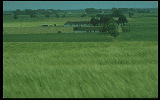
| 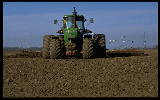
|
| Borrby area
| Preparing to sow
|
- Most people of this area works in the public sector and with
farming, fishing, fruit growing and connecting (related) industries.
Enginering industy and tourism have been growing in the last
years.
The geology in this area is intriguing, attracting scientists from
many countries. Archean rock forms are exposed on the Linderöd ridge
and in Stenshuvud National park. Sandstone is found around Simrishamn;
black alum-shale, limestone, clay slate and chalk further inland.
Geologically, Österlen has much in common with continental Europe. The
soil farmed today was originally brought here by the Baltic glaciers,
coming from an area rich in limestone. This gave fertile fields
without large stones. The best farming area in Sweden is found around
Hammenhög. Further north, in Brösarp and Rörum, the powerful ice
created dramatically beautiful gravel hills.
Österlen´s open landscape is not at all similar to the lake and castle
district to the north of Ystad. Here, the farms are smaller and, in
spite of modern farming methods, the atmosphere has maintained its
oldfashioned character.Österlen, therefore, is of great cultural
interest to the rest of Sweden.
Simrishamn has Österlen´s largest fishing fleet. The coastal waters
are host to cod, salmon, herring and eel. Fishingvessels from Blekinge
and Sweden´s west coast also bring their catches ashore in
Simrishamn´s modern harbour. Skillinge and Kivik have smaller active
fishing harbours. The other fishing villages such as Brantevik,
Baskemölla, Vik and Vitemölla, offer very genuine atmospheres, but
most boats there are used soley for private fishing and
recreation.
The fruit growing industry has its center around Vik och Kivik, taking
advantage of the east coast´s milder climate. A local winery produces
sparkling drinks from both apples and imported grapes, offering winetasting
tours in the Kronovall castle.
The coast and the fishing villages
-
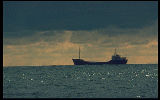
| 
| 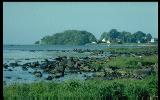
|
| Coastal trade
| Sandhammaren
| Gislövshammar
|
- The southeastern coast offers wide sandy beaches lined with beatiful
meadows; ideal for long walks and swimming. From the dunes and beaches of
Sandhammaren, the sandy coastline turns to the northeast, continuing past
Mälarhusen and Kyl, before turning to stony beaches near Skillinge.
Alum shale meets the sea near the small fishing village of Gislövshammar;
sandstone lines the shore at Grönet, south of Brantevik. To the north of
Simrishamn, a unique coarse sand forms Tobisvik, the world´s only habitat for
a certain microscopic crustean.
Grazing animals sculpt the seaside meadows near Tjörnedala, leaving wild
orchids and other rare herbs in a breathtaking landscape which was already
praised by Carl von Linné in the 18th Century. The silouette of Stenshuvud
dominates the coast leading to Kivik. North of Vitemölla, towards Haväng,
chalk-filled sand is host to many species of flowers. Here you can find St.
Bernard´s Lily.
An ancient monument lies where the Verke river runs out into Hanö bay.
The Nature and The Animals
-
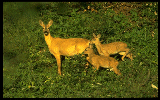
| 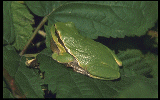
|
| Roe Deer with Fawn
| Tree frog
|
- The south of Scania was once covered with deciduous forest. Nowadays,
we only have areas with mostly planted beech forest, the finest example
being Maglehems Ora, near Brösarp. Fauna and flora are more varied
in the forests in Fyledalen, and the lake district north of Ystad.
The original Scanian Red Deer are numerous here; during the misty autumn
evenings, you can hear the calls of the large stags. Fallow Deer and Roe
Deer are also common, and even The Elk lives here. Escaped Wild Boars now
live wild, along with the Red Fox population which has recovered after
a battle with scabies.
Österlen lies in the center of the habitat of many frogs. The Green
Tree Frog likes the small ponds surrounded by bushes and meadows. The Agile
Frog and Spade Foot Toad also live here. The Green Toad prefers the ponds
near the east coast.
Birdlife varies during the year. Of primary interest are the migratory
flights during the spring and the autumn. Good observation points are
Sandhammaren and Brantevik. Many Eider Goose, Brent-Goose and a variety of
Ducks pass by together with the occasional tern. Divers and some Skua
can bee seen now and then. In early summer, warm air usually comes in from
southeast, attracting rare birds such as the Rosecoloured Starling , The
Bee-Eater and the Roller, often seen at Grönet near Brantevik. The spiny
bushes in Österlen´s open meadows are good breeding places for many
song-birds, and both The Whooper and The Crane breed in the shallow pools
hidden the forests.
The Red Kite has been concentrated around Tomelilla for many winters. Early
spring, they spread out to nest in high beech trees. The Kite population
has increased over the past years. Fyledalen is a wellknown observation
area for birds of prey in the winter. Golden Eagles and Sea Eagles are
hunting rabbits in the valleys while Buzzards and Kites wait their turn.
Culture and Art
-
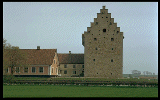
| 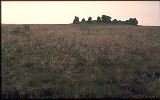
|
| Glimmingehus
| Havängsdösen
|
- Ales stone "ship" by Kåseberga, The Bredarör King´s Grave by Kivik
and the anchient dolmen, Havängsdösen, are reminders of mankind´s
history in Österlen. The 12th century churches and the medieval castles in Glimmingehus,
in Glimmingehus, Örup och Bollerup are younger monuments from our
history.
Österlen borders the sea towards the east and the south. This creates
a special light over the landscape witch has always attracted artists.
One of them, Prince Eugen from Sweden´s royal family, spent much time here
painting the pastoral hills. Dag Hammarsköld had a little cottage where
he withdraw from his UN duties to meditate. The poet Anders Österlind
walked along the coast by Haväng, inspired by the wiews.
Each Easter, Österlen becomes one enormous gallery,as artists open their
homes and studios to thousands of visitors, searching for the latest
masterpiece.
You are welcome to explore Österlen for yourselve.
You won´t be disappointed
© photos Göran Gustafson, text Göran Gustafson - Seth Selleck
Friaborgsskolans Home Page










